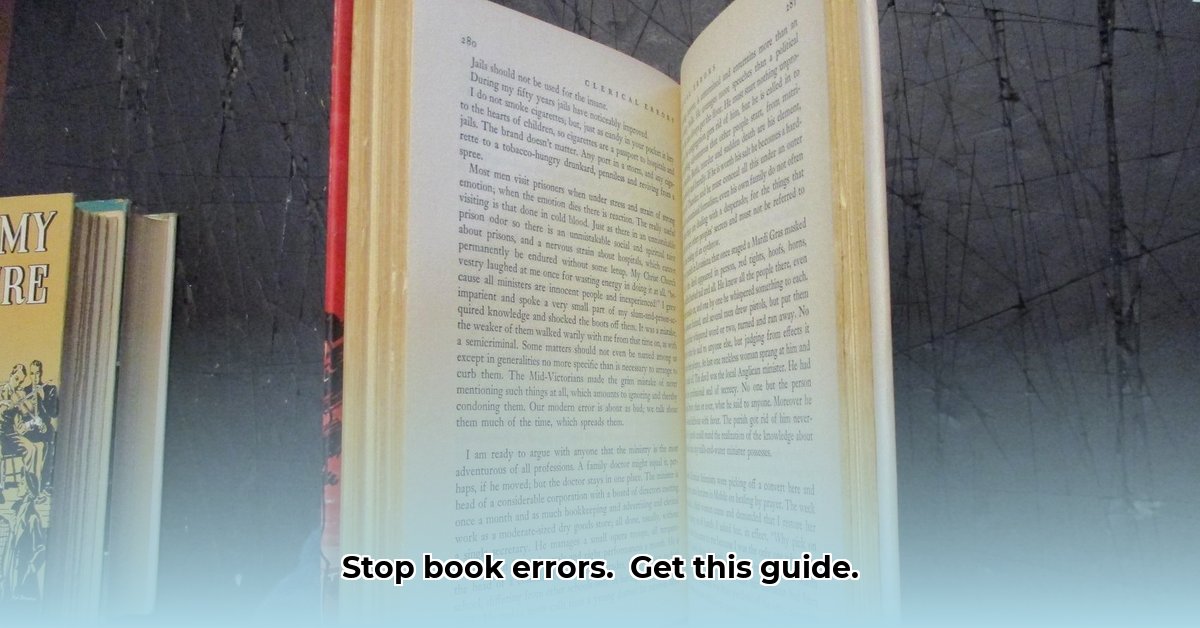Ever spotted a silly mistake in a book you’re reading? It happens more often than you’d guess! This article dives into the world of publishing errors – from tiny typos to big factual blunders – explaining why they happen and how to avoid them. We’ll look at what causes these mistakes, what happens when they slip through, and give you practical tips to make sure your own writing (or the books you’re working on) is as clean as possible. We’ll even cover how technology is changing the game and share advice from top editors and authors to help you create the best possible book. For similar reads, check out books like Ready Player One.
Errors in Books: A Comprehensive Guide
Ever spotted a typo in your favorite book manuscript or final version? It happens more often than you might think! Even with all our fancy technology, mistakes in books are a surprisingly common problem, impacting book sales and overall quality. We’re not just talking about a missing comma here; we’re talking about wrong facts, confusing storylines, and even grammatical goofs in books that should be perfect. So, what’s going on with these errors? The answer is complicated, and it involves a few different things.
The Race Against the Clock: A Modern Publishing Challenge
The digital age has made publishing much faster. But this speed often means less time for careful checking, resulting in higher error rates. The pressure to get books out quickly means there’s less time for thorough editing and proofreading. Many publishers now prioritize speed to market, leading to a potential compromise in quality control. Independent authors face similar pressures, juggling writing, editing, and marketing, often with limited resources. This hectic environment contributes significantly to the prevalence of errors.
What Kinds of Mistakes Show Up? The Many Faces of Errors
Mistakes in books come in all shapes and sizes.
- Typos: These are the most common, including spelling errors, punctuation problems, and incorrect word usage (like “there,” “their,” and “they’re”).
- Grammatical Errors: These involve incorrect sentence structure, verb tense issues, subject-verb agreement problems, and other violations of grammar rules.
- Factual Errors: These can be dates, historical details, scientific information, or any other verifiable fact that is presented incorrectly.
- Plot Holes: These are inconsistencies or gaps in the storyline.
- Character Inconsistencies: When a character behaves in a way that doesn’t align with their established personality or background.
- Formatting Issues: These can be inconsistent fonts, spacing problems, or incorrect chapter headings.
Who’s on the Case? The Team Behind a Book’s Accuracy
Preventing mistakes is a team effort.
- Authors: Responsible for the initial writing and self-editing. They should conduct thorough research and fact-checking.
- Developmental Editors: Focus on the overall structure, plot, and character development.
- Copy Editors: Check for grammatical errors, typos, inconsistencies, and adherence to style guidelines.
- Proofreaders: Conduct a final review of the text to catch any remaining errors before publication.
- Publishers: Oversee the entire process and ensure quality control standards are met.
Technology also plays a role; special software can help find possible problems. But, no system is foolproof; a human eye is still incredibly important.
How Can We Catch More of Those Pesky Errors? Practical Strategies
Here are strategies to improve the accuracy of a book’s final draft:
1. Authors’ Self-Editing: Authors need to spend a lot of time reviewing their work. This means doing several checks, ideally with breaks in between to see it with fresh eyes. Use tools like Grammarly or ProWritingAid, but always double-check their suggestions.
2. Professional Editing is Key: Hiring an editor who’s great at finding mistakes is essential. A good editor will find things that the author inevitably misses. Look for editors with experience in your genre.
3. Get Feedback from Beta Readers: Beta readers are individuals who read your manuscript before publication and provide feedback. They can catch plot holes, character inconsistencies, and other issues that you might have missed.
4. Proofreading is Vital: A dedicated proofreader, someone who’s familiar with style guides, is indispensable. They’re the final line of defense against typos and inconsistencies.
5. Read Aloud: Reading your manuscript aloud can help you catch errors that you might not see when reading silently.
6. Harnessing Technology: While not a replacement for human eyes, grammar-checking software and other tools can help. But always double-check the suggestions; computers aren’t perfect.
7. Print It Out: Reviewing a printed copy of your manuscript can help you spot errors that you might miss on a screen.
Technology’s Two Sides: Helping and Hindering
Technology is a double-edged sword when it comes to catching errors in ebooks and printed books.
| Technology | Pros | Cons |
|---|---|---|
| AI-powered proofreading tools | Fast, finds typical mistakes | Misses nuanced errors and writing style issues |
| Automated spell-checkers | Catches typos and simple grammar errors | Doesn’t understand context, can give false alarms |
| Collaborative editing platforms | Easy feedback, keeps track of changes | Relies on everyone actively participating |
| Text-to-speech software | Helps identify awkward sentences | Can be monotonous and miss subtle errors |
You Can Help Too: Readers as Error Detectives
Readers also play a crucial role! If you find a mistake, let the publisher or author know. Many publishers have a dedicated email address or form on their website for reporting errors. This helps them correct the error in future versions of the book, either in print or online. It’s a team effort to make books as error-free as possible.
Case Studies: Famous Errors in Published Books
- The Wicked Bible: A 1631 edition of the King James Bible omitted the word “not” from the commandment “Thou shalt not commit adultery.”
- “Dord” in Webster’s Dictionary: The word “dord” was mistakenly included in the 1934 edition of Webster’s New International Dictionary as a synonym for density.
- “Wonton” instead of “Wanton”: In Karen Harper’s The Queen’s Governess, the word “wonton” was used instead of “wanton,” creating a humorous and unintended image.
The Bottom Line: Perfection is a Goal, Not a Guarantee
Completely eliminating mistakes from books is probably impossible. But striving for accuracy is incredibly important. It involves everyone from the author writing the first draft to the reader turning the final page. It’s a shared responsibility. By following the tips and strategies outlined in this guide, you can significantly reduce the number of errors in your books and improve the overall reading experience for your audience.
How to Prevent Costly Factual Errors in Self-Published Books
Releasing a self-published book is an exciting endeavor, but it also comes with its share of challenges. One of the most significant is ensuring accuracy and avoiding factual errors that can damage your reputation and impact sales.
The High Cost of Inaccuracy
Releasing a book riddled with factual errors can severely damage your reputation and sales, leading to negative reviews, loss of credibility, and potentially legal issues. It’s a costly mistake, both financially and in terms of reader trust.
Fact-Checking: Beyond Spellcheck
Think of fact-checking as your book’s insurance policy, protecting your credibility and minimizing potential damage. It’s not just about catching typos; it’s about ensuring accuracy across the board.
Steps for Rigorous Fact-Checking:
- Create a Fact-Checking Document: Compile all potentially questionable information in a central location.
- Source Verification: For every fact, find at least two reliable sources to corroborate the information. Note the source in your document.
- Consistency Check: Ensure consistency across your manuscript. Contradictory information is a major red flag.
- Expert Consultation (If Needed): For complex topics, seek guidance from relevant experts to validate your research.
- Use Reputable Sources: Rely on academic journals, government publications, and established news organizations for information.
- Cross-Reference Information: Verify facts across multiple sources to ensure accuracy.
- Pay Attention to Detail: Double-check names, dates, locations, and other specific details.
Professional Editing: Your Secret Weapon
Hiring a professional editor is one of the best investments you can make. They can catch errors you might miss, ensuring better quality and higher reader satisfaction.
Choosing the Right Editor:
- Developmental Editor: For overall story structure and plot.
- Copy Editor: For grammar, style, and consistency.
- Fact-Checker: Specifically reviews the manuscript for factual accuracy.
- Proofreader: For final typo and formatting checks.
Mastering Metadata and Marketing
Metadata is how your book is found online, influencing search engine ranking and discoverability. Poorly written descriptions and inaccurate keywords severely limit your visibility, reducing potential readership.
Metadata Optimization:
- Keywords: Use relevant, high-volume keywords.
- Description: Write a compelling description highlighting the book’s unique selling points.
- **Category
- Unlock Your Potential with Adult Vocal Lessons at Any Age - January 8, 2026
- Adult Voice Lessons Transform Your Singing and Build Confidence - January 7, 2026
- Vocal Performance Artistry Requires Unmatched Control and Emotional Depth - January 6, 2026










